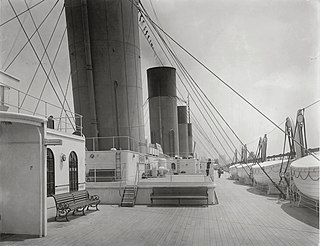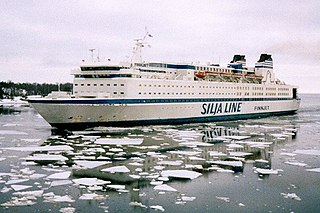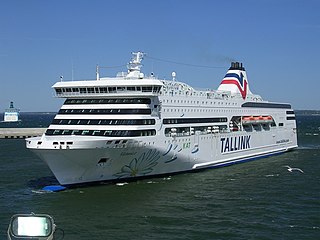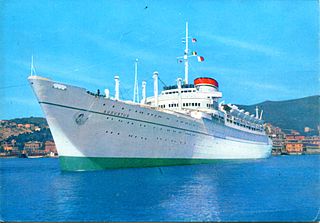Silja Line was a Finnish cruiseferry brand operated by the Estonian ferry company AS Tallink Grupp, for car, cargo and passenger traffic between Finland and Sweden.

A deck is a permanent covering over a compartment or a hull of a ship. On a boat or ship, the primary or upper deck is the horizontal structure that forms the "roof" of the hull, strengthening it and serving as the primary working surface. Vessels often have more than one level both within the hull and in the superstructure above the primary deck, similar to the floors of a multi-storey building, that are also referred to as decks, as are certain compartments and decks built over specific areas of the superstructure. Decks for some purposes have specific names.

GTS Finnjet was a cruiseferry, built in 1977 by Wärtsilä Helsinki Shipyard, Finland for Finnlines traffic between Finland and Germany. At the time of her delivery, Finnjet was the fastest, longest and largest car ferry in the world, and the only one powered by gas turbines. At the point of her scrapping in 2008, she remained the fastest conventional ferry in the world, with a recorded top speed of 33.5 knots.

MS Silja Serenade is a cruiseferry owned by the Estonian shipping company Tallink Grupp, operating under their Silja Line brand on a route connecting Helsinki to Stockholm via Mariehamn. She was built in 1990 by Masa-Yards at Turku New Shipyard, Finland. From 26 June 2020, to 13 September 2020, the ship's route was Helsinki–Riga, which got replaced by the cruiseferry M/S Baltic Queen

MS Silja Symphony is a cruiseferry owned by the Estonian shipping company Tallink Group, operated under their Silja Line brand on a route connecting Helsinki, Finland to Stockholm, Sweden via Mariehamn. She was built in 1991 at Masa-Yards Turku New Shipyard, Finland.

Celestyal Crystal, previously Louis Cristal, is a cruise ship operated by the Cyprus-based Celestyal Cruises and previously Louis Cruise Lines, both in the Louis Group. The ship was originally built as the cruiseferry MS Viking Saga in 1980 at Wärtsilä Perno Shipyard and Turku Shipyard, Turku, Finland for Rederi Ab Sally. In 1986 she was renamed MS Sally Albatross, and rebuilt into a cruise ship the following year. The ship was destroyed by a fire in 1990, and completely rebuilt at Finnyards, Rauma, Finland. She was re-delivered in 1992, still named Sally Albatross. After partially sinking 1994 she was rebuilt at Industrie Navali Meccaniche Affini, La Spezia, Italy, re-entering service as MS Leeward for Norwegian Cruise Line. Subsequently she sailed as MS SuperStar Taurus for Star Cruises, MS Silja Opera for Silja Line and spent a year laid up as MS Opera prior to entering service with her current owner in 2007.

A cruiseferry is a ship that combines the features of a cruise ship with a Ro-Pax ferry. Many passengers travel with the ships for the cruise experience, staying only a few hours at the destination port or not leaving the ship at all, while others use the ships as means of transportation.

MS Bore is a combination museum and hotel ship docked permanently in Turku, Finland. She was originally built in 1960 by Oskarshamn shipyard, Oskarshamn, Sweden as the car/passenger ferry SS Bore for Steamship Company Bore, Finland, then the last commercial steam ship built in Scandinavia and the first ferry on the route between Finland and Sweden where cars could drive aboard. She was later known as SS Borea, before being rebuilt as cruise ship in 1988. 1988 to 2010 she was owned by the Finnish shipping company Kristina Cruises and known as MS Kristina Regina until she was retired because she did not comply with new safety regulations.

MS Marella Dream is a cruise ship previously owned by TUI UK Ltd. and operated under charter by Marella Cruises. She was built in 1986 at the Meyer Werft shipyard in Papenburg, West Germany as MS Homeric for Home Lines. In 1988 she was sold to Holland America Line and renamed MS Westerdam. In 1990 she was lengthened by 36.9 m at Meyer Werft. In 2002 she was transferred to the fleet of Costa Cruises and renamed MS Costa Europa. In April 2010 she left the fleet of Costa Cruises on a ten-year charter to Thomson Cruises, under the name MS Thomson Dream. She is the last new build for Home Lines to remain in active service.

MS Galaxy is a cruise ferry built in 2006 by Aker Finnyards, Rauma, Finland and was at the time the largest ship delivered to ferry operator Tallink. Between 2006–2008 she held the distinction of being the largest ship ever to be registered in Estonia; a title later held by her replacement the sister ship Baltic Princess.

MS Victoria I is a cruiseferry operated by the Estonian ferry company Tallink on a route connecting Stockholm, Sweden to Tallinn, Estonia via Mariehamn, Finland. She was built in 2004 by Aker Finnyards, Rauma. Although the ship's official name is Victoria I, she is often referred to as Victoria, without the number. This is also the name displayed on top of her superstructure, whereas the name is written in full form on the hull.

MS Salamis Filoxenia is a cruise ship owned by the Cyprus-based Salamis Cruises. She was built in 1975 by Wärtsilä Turku Shipyard as the Belorussiya class-cruiseferry Gruziya for the Black Sea Shipping Company, Soviet Union. She was rebuilt into a cruise ship during the 1980s. In 1995, she was renamed Odessa Sky and in 1999 briefly Club 1 before renamed Van Gogh later in 1999. In 2009, she was acquired by her current owner and renamed Salamis Filoxenia.

The Baltic Sea is crossed by several cruiseferry lines. Some important shipping companies are Viking Line, Silja Line, Tallink, St. Peter Line and Eckerö Line.

MS Sea Diamond was a cruise ship operated by Louis Hellenic Cruise Lines. She was built in 1984 by Valmet, Finland for Birka Line as Birka Princess. The ship sank on 5 April 2007, after running aground near the Greek island of Santorini the previous day, leaving two passengers missing and presumed dead.

MS Stena Saga is a cruiseferry owned by the Swedish shipping company Stena Line and was operating mainly on their route connecting Oslo, Norway to Frederikshavn, Denmark until March 2020, after that the route was closed down. She was built as MS Silvia Regina in 1981 by Wärtsilä Turku, Finland for Rederi AB Svea for use in Silja Line traffic. The ship joined Stena Line fleet in 1991, originally with the name MS Stena Britannica.
MS Palm Beach Princess was a cruise ship operated by Palm Beach Cruises on casino cruises out of the Port of Palm Beach in Riviera Beach, Florida. She was built in 1964 by Wärtsilä Hietalahti shipyard, Helsinki, Finland for Finland Steamship Company as Ilmatar. From 1970 until 1974 and again from 1978 to 1980 she was marketed as a part of Silja Line fleet. In 1973 she was lengthened at HDW Hamburg, Germany by 20.04 m. Between 1975–1976 she was chartered to Finnlines. In 1979 she was converted to a cruise ship.

The Belorussiya class cruiseferries were built by Wärtsilä Turku Shipyard, Finland in 1975–1976 for the Black Sea Shipping Company, Soviet Union. The five ships in the class were originally used in ferry service around the Black Sea. During the 1980s all ships in the class were rebuilt into cruise ships. During the end of the 1990s all ships in the class were sold to other operators. As of 2008, at least four ships in this class were in service. The effects of the new SOLAS regulations that came into effect in 2010 remain unknown.

MS Augustus was a 27,090 GRT, luxury ocean liner built in 1950 for Italian Line. She was the sister ship to MS Giulio Cesare that was launched in the same year. These two ships were built to the same design, with similar specifications. After the Augustus was sold to Hong Kong, she sailed under five names. The ship was later sold to Manila Hotel and renamed MS Philippines, functioning as a static hotel. As reported by both Maritimematters, and maritime, the MS Philippines was sold for scrap in September 2011. As of December 2011, she was beached in Alang for scrapping.

SS Stella Solaris was an ocean liner built for Messageries Maritimes in 1952. She mainly provided passenger service between France, the Middle East, Southeast Asia, and Japan.
SS Atlantic was an American-built vessel that operated for 42 years in various capacities. First designated SS Badger Mariner, she was originally built as a freighter in 1953. However, her career as a cargo vessel was relatively short. In 1958, she was rebuilt as a passenger liner. Renamed SS Atlantic, this ship became familiar to many American tourists during the 1960s, making cruises to the Caribbean and Mediterranean.



















